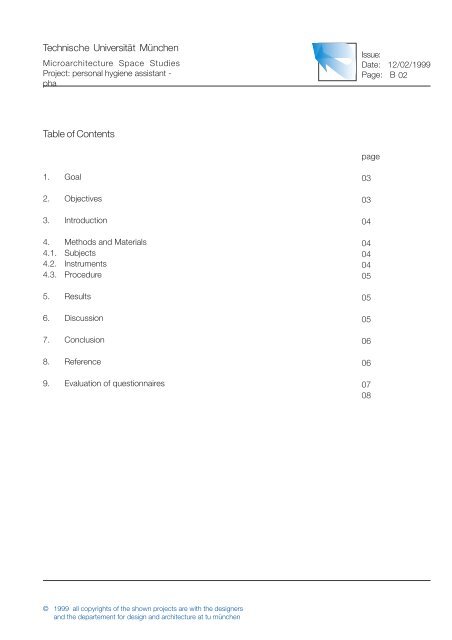Microarchitecture Space Studies Report - Technische Universität ...
Microarchitecture Space Studies Report - Technische Universität ... Microarchitecture Space Studies Report - Technische Universität ...
Technische Universität München Microarchitecture Space Studies Project: personal hygiene assistant - pha Table of Contents 1. Goal 2. Objectives 3. Introduction 4. Methods and Materials 4.1. Subjects 4.2. Instruments 4.3. Procedure 5. Results 6. Discussion 7. Conclusion 8. Reference 9. Evaluation of questionnaires © 1999 all copyrights of the shown projects are with the designers and the departement for design and architecture at tu münchen Issue: Date: 12/02/1999 Page: B 02 page 03 03 04 04 04 04 05 05 05 06 06 07 08
Technische Universität München Microarchitecture Space Studies Project: personal hygiene assistant - pha Title: PHA - personal hygiene assistant Flight Dates: Oct. 26. - Oct. 29.1999 Principal Investigators: Bianca Artopé, Brigitte Borst Co-Investigators: Andreas Vogler, Constance Adams, Nigel Packham, Hubert Brasseaux, Ketan S. Chhipwadia, Mary Ellen Weber, Julia Habel, Claudia Hertrich, Ralf Kircher 1. Goal Proof the function of PHA in microgravity 2. Objective Subject of testing is a new full-body cleansing device for astronauts in micro gravity. It is a well known problem that the three methods of body hygiene - washing, bathing, showering - are almost not practicable in micro gravity. Right now astronauts use prepacked damp towels as a substitute for taking a shower. Since November 1998 we were, in collaboration with JSC, developing the „personal hygiene assistant“ , short: PHA. This device was tested in a KC135 flight as a new, easy and effective alternative for full body cleansing. The device itself - similar to a shower head - is small enough to suit a palm and allows easy handling, as former tests already proofed. The body of the device holds a sponge in the middle . The water is injected into the sponge. A cellulose cover on top of the sponge will be touching the skin during the cleansing process and is able to take off greasy parts from the skin. This cover will be exchanged more often than the sponge. Like a ring on the outer edge of the device the suction channels are located. Therefore no water can escape and the water flow will be controlled. Another advantage is the minimization of the water consumption. Former tests with the device on the ground show that the principle functions very well. KC135 gave us a very important possibility to proof this principle in micro gravity and gain comparable test data. © 1999 all copyrights of the shown projects are with the designers and the departement for design and architecture at tu münchen Issue: Date: 12/02/1999 Page: B 03
- Page 1 and 2: © 1999 all copyrights of the shown
- Page 3 and 4: Technische Universität München Mi
- Page 5 and 6: Technische Universität München Mi
- Page 7 and 8: Technische Universität München Mi
- Page 9: Technische Universität München Mi
- Page 13 and 14: Technische Universität München Mi
- Page 15 and 16: Technische Universität München Mi
- Page 17 and 18: Technische Universität München Mi
- Page 19 and 20: Technische Universität München Su
- Page 21 and 22: Technische Universität München Su
- Page 23 and 24: Technische Universität München Mi
- Page 25 and 26: Technische Universität München Mi
- Page 27 and 28: Technische Universität München Mi
- Page 29 and 30: Technische Universität München Mi
- Page 31 and 32: Technische Universität München Mi
- Page 33 and 34: Technische Universität München Mi
<strong>Technische</strong> <strong>Universität</strong> München<br />
<strong>Microarchitecture</strong> <strong>Space</strong> <strong>Studies</strong><br />
Project: personal hygiene assistant -<br />
pha<br />
Table of Contents<br />
1. Goal<br />
2. Objectives<br />
3. Introduction<br />
4. Methods and Materials<br />
4.1. Subjects<br />
4.2. Instruments<br />
4.3. Procedure<br />
5. Results<br />
6. Discussion<br />
7. Conclusion<br />
8. Reference<br />
9. Evaluation of questionnaires<br />
© 1999 all copyrights of the shown projects are with the designers<br />
and the departement for design and architecture at tu münchen<br />
Issue:<br />
Date: 12/02/1999<br />
Page: B 02<br />
page<br />
03<br />
03<br />
04<br />
04<br />
04<br />
04<br />
05<br />
05<br />
05<br />
06<br />
06<br />
07<br />
08



